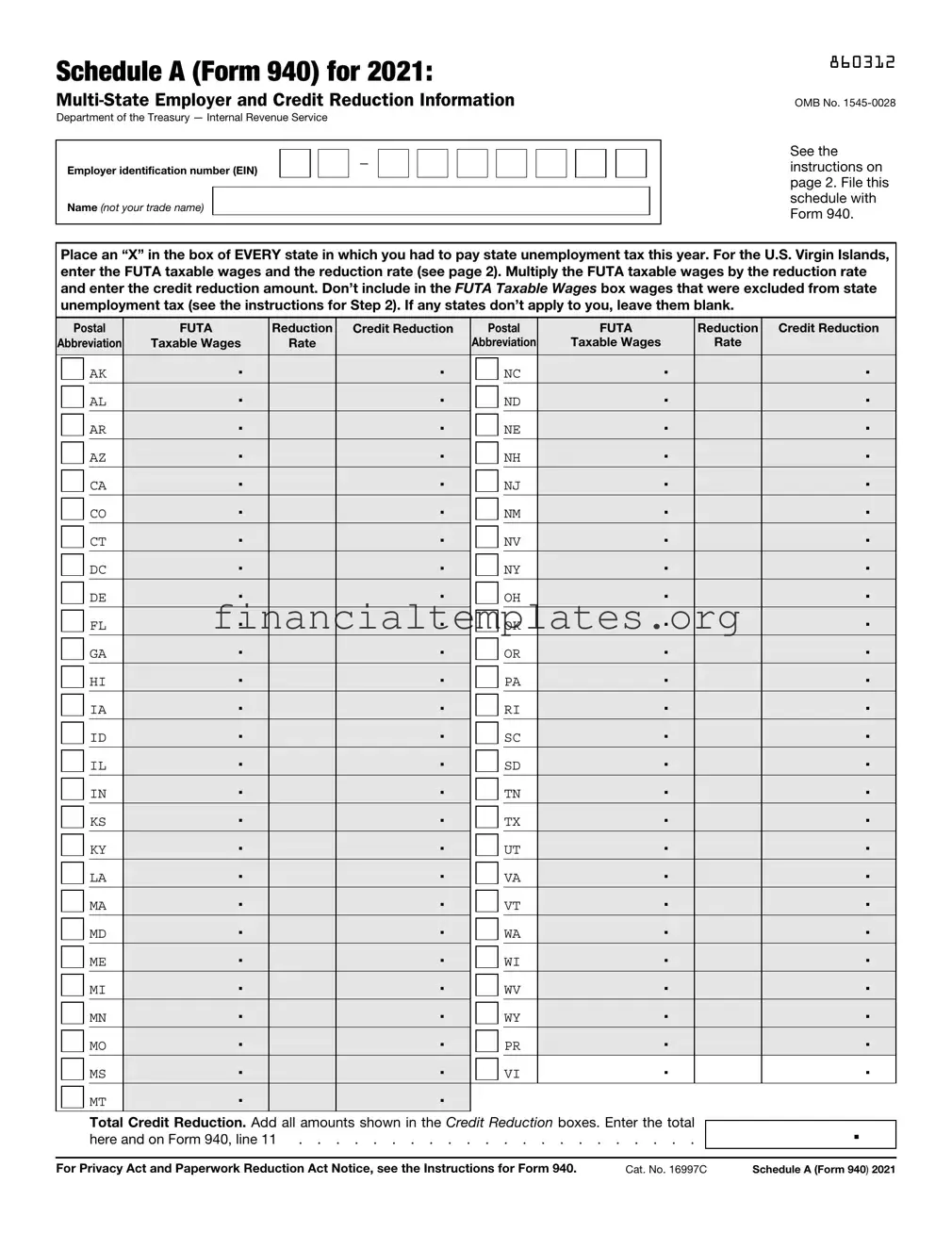The IRS Form 940 is a federal tax form used by employers to report their annual Federal Unemployment Tax Act (FUTA) tax. Schedule A (Form 940) serves a specific function similar to that of Form 941, Employer's Quarterly Federal Tax Return. While Form 940 is an annual summary, Form 941 is filed quarterly, detailing an employer's withholding of income taxes and Social Security and Medicare taxes. Both forms require employers to report amounts related to payroll taxes, though for different purposes and time periods, making them interconnected in the overarching process of payroll tax reporting.
Form W-2, Wage and Tax Statement, is similar to Schedule A (Form 940) in that it involves reporting employment taxes. Form W-2 is issued by employers to employees and the Social Security Administration, detailing an employee's annual wages and the amount of taxes withheld from their paycheck. Like Schedule A, it is integral to tax filing for both individuals and employers, focusing on the specifics of wages and tax withholdings, which play a role in determining FUTA liability.
Form W-3, Transmittal of Wage and Tax Statements, complements Form W-2 by summarizing the total earnings, Social Security wages, Medicare wages, and withholding for all employees of a business. This form, akin to Schedule A (Form 940), aggregates information pertinent to employment taxes, albeit primarily aimed at the Social Security Administration. It facilitates an overview, similar to how Schedule A consolidates state unemployment taxes for multi-state employers.
The State Unemployment Tax Act (SUTA) forms, although specific to each state, share a core purpose with Schedule A (Form 940), highlighting employment tax obligations at the state level. SUTA forms require employers to report wages paid to employees and calculate unemployment tax due to the state. This directly relates to the information needed on Schedule A, as state unemployment taxes influence the credit reduction calculation on FUTA taxes.
Form 1099-NEC, Nonemployee Compensation, is used to report payments to independent contractors and is somewhat analogous to Schedule A (Form 940) in its role in tax reporting. While Form 940 Schedule A focuses on the employer's state unemployment tax obligations, Form 1099-NEC addresses the reporting of payments that aren't subject to withholding but are still relevant for the contractor's income taxes. Both are essential for accurate tax reporting, ensuring that different kinds of worker compensation are documented.
Form 1096, Annual Summary and Transmittal of U.S. Information Returns, operates similarly to Schedule A (Form 940) by serving as a summary document. Form 1096 is used to transmit paper copies of all Form 1099, 1098, and other information returns filed by an entity to the IRS. Like Schedule A, which aggregates credit reduction information, Form 1096 compiles data from multiple forms for submission, playing a crucial summary role in the context of informational returns.
Form 944, Employer's ANNUAL Federal Tax Return, is designed for smaller employers to report their federal income tax withholding and FICA taxes once a year rather than quarterly. This form's relation to Schedule A (Form 940) lies in its annual reporting frequency and focus on employment taxes. Both cater to specific employer needs, with Form 944 offering a simplified, once-a-year filing alternative that still encompasses critical tax information, akin to how Schedule A clarifies multi-state unemployment tax liabilities.
Form 945, Annual Return of Withheld Federal Income Tax, is for reporting federal income tax withheld from non-payroll payments, such as gambling winnings, and backup withholding. It parallels Schedule A (Form 940) by targeting a particular aspect of tax reporting (withholding on specific payments) and necessitating annual filing. Both forms play specific roles in ensuring the proper reporting and payment of taxes related to payments the business makes.
Form SS-4, Application for Employer Identification Number (EIN), while not a tax return, is crucial for businesses to file taxes correctly, including Schedule A (Form 940). Obtaining an EIN is a pre-requisite for filing employment taxes, making Form SS-4 foundational. Just as Schedule A categorizes state unemployment taxes, Form SS-4 initiates a business's tax reporting process by assigning the unique identifier necessary for all future tax documentation and correspondence with the IRS.
Schedule B (Form 941), Report of Tax Liability for Semiweekly Schedule Depositors, directly relates to Form 941 but shares core reporting elements with Schedule A (Form 940). It demands a more frequent and detailed report of tax liabilities. Unlike the annual aggregation in Schedule A, Schedule B breaks down tax liabilities by pay period for more precise tracking and payment. Both schedules augment a primary form, supplying necessary, detailed information that fulfills the employer's tax reporting obligations.


